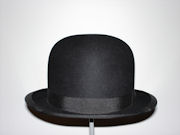Is it a Bowler, or a Derby?

The Bowler Hat, along with the Top Hat, is probably the most commonly known of hat styles of the current day. The top Hat was essential headwear for men throughout the 1800s and no man was well dressed, day or night, without wearing this style of Hat. The top hat lost its appeal as a daily fashion accessory for men by the dawn of the 20th century, and was replaced by other forms of headwear, such as derby hats, and then the fedora.
A bowler hat is also known as a derby hat. It’s a rounded, hard-topped hat with a small brim. Black is the classic color of this hat and the hat may have a matching band around its crown, or middle. Wool felt is the classic fabric used to make derby hats.
Sheep's wool is usually the only wool used to make wool felt derby hats, as it gives a nice, hard strength to the hat. Rabbit fur felt and beaver felt are used when softer hats are wanted and are not usually used to make this hat style.
The derby hat was originated in 1850. It was invented for British game warden, James Coke of Norfolk, as he wanted a sturdy hat to wear while he was on horseback looking for poachers on his property. The Top Hat was then in vogue so my guess is that the rounder style would have been more practice.
They first called it a Coke hat, which was actually made by the Bowler family of Southwark and the hat gradually took their name as its popularity grew. Soon, all types of men were wearing derbies, from bankers to bus drivers. Men of every social and economic class wore these hats and the derby is noted as being the first hat that was mass produced to be affordable for all men.
The derby hat was one of the most popular men's hats for almost seventy years. Men began wearing these hats rather than top hats in the 1850s and then began wearing fedora hats rather than derby hats in the 1920s. However, comedy stars Laurel and Hardy each wore a derby hat throughout the 1920s and 1930s in their movies and it was their signature style. Even stores selling hats today have names for their derbies such as the Laurel and Hardy Bowler and the Laurel and Hardy Derby Hat.
Silent film star Charlie Chaplin also wore a signature derby hat. It represented the pathetic vulnerability of the man whose dignity derives from his hat. Coupled with his shabby suit, crooked walking stick and absurdly cocky walk, Chaplins hat signalled to cinema audiences that here was an embattled little man using his hat to give him solidity and importance. The fact that both hat and man were always being knocked off their pedestals made the character irresistible.
Some women also wore derby hats even though originally they were sold as men's hats. Women who performed in the circus or in cabarets were known to wear these hats and they were later sold as a woman's hat.
Hats express social attitudes and are as limited by convention as any other item of dress, says Colin McDowell, in his book "Hats, status, style and Glamour". Hats proclaimed the man - his status, attitudes and beliefs - and the woman - her class, breeding and even matrimonial state. The poke bonnet and the mob cap survived much longer on unmarried (or widowed) heads than on those of married women or girls.
What women wore was a question of fashion, but men's clothes were dictated by convention. As the St James' Gazette commented in 1890, 'When we are told, "He's a fellow who wears a pot hat and frock coat" we know sufficiently well what sort of fellow he is'. It was understood that no member of polite society would wear a frock coat without the appropriate and sanctioned top hat, keeping the pot hat, or bowler, for less formal wear.
It was a nineteenth rule, as flexible and immutable, it seemed, as the edict that 'On the Sabbath all respectable men sport a Topper'. Wall Street and the City were the place where, in honour of the god of money, formality was rigidly applied to the rules of dress, yet after World War 1 the inconceivable began to happen even there. Men were seen wearing morning coats with Bowlers, a combination that in pre-war days would have been the unforgivable sartorial sin. No that the Bowler was an unacceptable hat, it was simply not formal enough for morning coats.
As the twentieth century progressed more and more women took up hunting as a sport. The rules of headwear were predictably strict and wore copies of men's hats. In 1953 one guide to hunting dress was still insisting that a lady wearing a hunting silk hat should also wear a veil. When not hunting, a fashionable lady would ride in the Bios du Boulogne, Central Park or Rotten Row, in order to be seen.
These women were not all 'ladies'. The Achilles Statue in Rotten Row had long been the congregation point for high-class prostitutes, magnificently dress, in beautifully turned out carriages or mounted on the most high mettled horses. Known to their clients as 'the pretty horse-breakers', these women were London fashion leaders. When Skittles, one of Victorian London's most famous prostitutes, appeared in a snappy round topped riding bowler, all the ladies who condemned her and her trade rushed to follow her lead and a new fashion was created.
This fashion has still been retained through to the current day, even though a hat is rarely worn in comparison to that time. Like the Top hat, the rounded style of the Bowler is often pictured in Bridal magazines as an alternative to the wedding veil for the bride.
